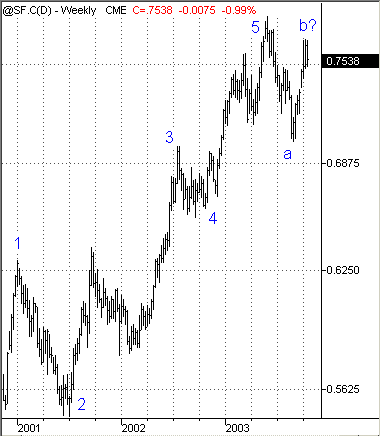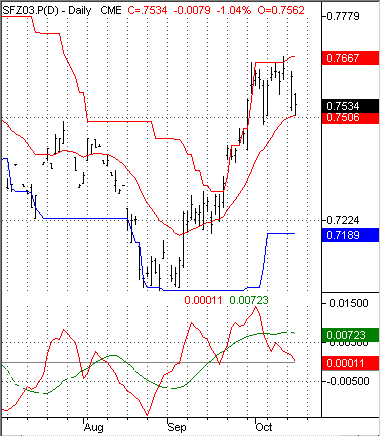
HOT TOPICS LIST
- MACD
- Fibonacci
- RSI
- Gann
- ADXR
- Stochastics
- Volume
- Triangles
- Futures
- Cycles
- Volatility
- ZIGZAG
- MESA
- Retracement
- Aroon
INDICATORS LIST
LIST OF TOPICS
PRINT THIS ARTICLE
by David Penn
Its "B" wave all but complete, the Swiss franc looks set to renew a correction of its three-year bull market.
Position: N/A
David Penn
Technical Writer for Technical Analysis of STOCKS & COMMODITIES magazine, Working-Money.com, and Traders.com Advantage.
PRINT THIS ARTICLE
ELLIOTT WAVE
The Fading Swiss Franc
10/16/03 10:02:18 AMby David Penn
Its "B" wave all but complete, the Swiss franc looks set to renew a correction of its three-year bull market.
Position: N/A
| Like the stock market, which has been enjoying the renewed confidence and anxious enthusiasm characteristic of a second wave in a bear market (the second wave beginning in October 2002), those bullish on global currencies such as the Swiss franc have experienced a much-appreciated snapback rally in the wake of the sharp corrections that began in the summer of 2003. |
| I have been suggesting that global currencies -- from the Swiss franc to the euro to the British pound were looking particularly "toppy" since June when they began moving downward in earnest (see my article "Head and Shoulders Top in European Currencies," Traders.com Advantage, June 23, 2003). Time bore this observation out. Consider the following: the December euro peaked at the end of May at 1.1860 and fell to 1.0746 by the beginning of September. The Swiss franc peaked at the end of May at 0.7780 and fell to 0.7042 by the end of August. The British pound peaked in mid-June at 1.6690 and fell to 1.5512 by the end of August. |

|
| Figure 1: This wave count of the Swiss franc’s bull market since late 2000 points to a wave “C” correction in the near-term. |
| Graphic provided by: TradeStation. |
| |
| All of these currencies rebounded from those early fall lows and moved higher into October -- though none of them took out their old summer highs (the so-called "resource" currencies are a somewhat different story, as both the Canadian and Australian dollars did in fact set new highs this fall). These advances reignited bullish sentiment among those who had profited handsomely during the three-year bull markets in currencies like the Swiss franc. But there is growing reason to doubt the staying power of these late fall moves up. My Elliott wave count of the bull market in the Swiss franc suggests that the summer highs represented the top. Applying Robert Fischer's method for forecasting Elliott wave tops using Fibonacci numbers (see his book Fibonacci Applications and Strategies for Traders), the wave one projection of the wave five peak is 0.7616 and the wave three projection of the wave five peak is 0.7891. Taking the average of these two projections gave us a projected top of 0.7754, which turns out to be 75 points shy of the peak basis continuous futures (the peak, basis December, was 0.7780). |
Thus, if the summer highs represent the top of the bull market that began in October 2001, then the price action since then has been corrective. Specifically, the move down from the summer highs to the early autumn lows is most likely an "A" wave down. This means that the Swiss franc is currently enjoying a "B" wave back to the upside. As mentioned before with regard to the "resource" currencies, this "B" wave may in fact take prices higher than the highs of the summer of 2003.  Figure 2: A negative divergence develops between the 3/10 oscillator and price action in the December Swiss franc. However, if the Swiss franc is any indication, then the idea of these "B" waves taking out the summer highs looks increasingly less likely. As Figure 2 suggests, the fall rally in the Swiss franc appears to be losing steam, as a negative divergence begins to develop in October. While price action in the Swiss franc appears to level off, the 3/10 oscillator has turned down sharply, and is moving toward a test -- if not a penetration -- of the zero line. The December contract also shows the Swiss franc trying to find support along its 20-day exponential moving average. Should support at this level fail, then it will be likely that the "B" wave advance in the Swiss franc is over, and that a correction to perhaps as low as the lows of last summer (0.6552, basis continuous futures). |
| My last discussion of the Swiss franc ("Swing Low Swiss Franc," Traders.com Advantage, September 11, 2003) suggested that the Swiss franc might continue to move below its early September levels. As this discussion shows, these early September levels marked the bottom of the "A" wave decline in the Swiss franc. What is shown in the figure as wave ii of wave c in "Swing Low Swiss Franc" is more probably the wave c bottom, and not merely a stage in a further decline. |
Technical Writer for Technical Analysis of STOCKS & COMMODITIES magazine, Working-Money.com, and Traders.com Advantage.
| Title: | Technical Writer |
| Company: | Technical Analysis, Inc. |
| Address: | 4757 California Avenue SW |
| Seattle, WA 98116 | |
| Phone # for sales: | 206 938 0570 |
| Fax: | 206 938 1307 |
| Website: | www.Traders.com |
| E-mail address: | DPenn@traders.com |
Traders' Resource Links | |
| Charting the Stock Market: The Wyckoff Method -- Books | |
| Working-Money.com -- Online Trading Services | |
| Traders.com Advantage -- Online Trading Services | |
| Technical Analysis of Stocks & Commodities -- Publications and Newsletters | |
| Working Money, at Working-Money.com -- Publications and Newsletters | |
| Traders.com Advantage -- Publications and Newsletters | |
| Professional Traders Starter Kit -- Software | |
Click here for more information about our publications!
PRINT THIS ARTICLE

|

Request Information From Our Sponsors
- StockCharts.com, Inc.
- Candle Patterns
- Candlestick Charting Explained
- Intermarket Technical Analysis
- John Murphy on Chart Analysis
- John Murphy's Chart Pattern Recognition
- John Murphy's Market Message
- MurphyExplainsMarketAnalysis-Intermarket Analysis
- MurphyExplainsMarketAnalysis-Visual Analysis
- StockCharts.com
- Technical Analysis of the Financial Markets
- The Visual Investor
- VectorVest, Inc.
- Executive Premier Workshop
- One-Day Options Course
- OptionsPro
- Retirement Income Workshop
- Sure-Fire Trading Systems (VectorVest, Inc.)
- Trading as a Business Workshop
- VectorVest 7 EOD
- VectorVest 7 RealTime/IntraDay
- VectorVest AutoTester
- VectorVest Educational Services
- VectorVest OnLine
- VectorVest Options Analyzer
- VectorVest ProGraphics v6.0
- VectorVest ProTrader 7
- VectorVest RealTime Derby Tool
- VectorVest Simulator
- VectorVest Variator
- VectorVest Watchdog
